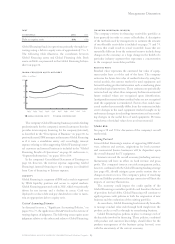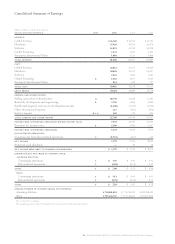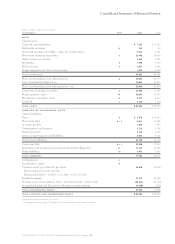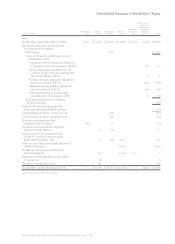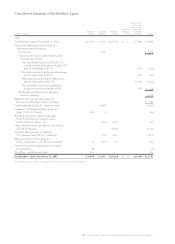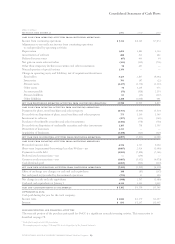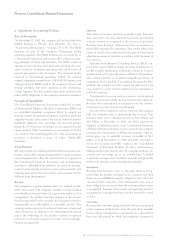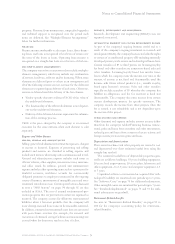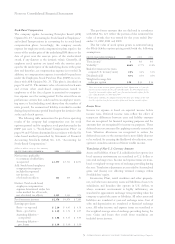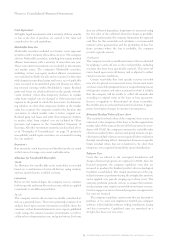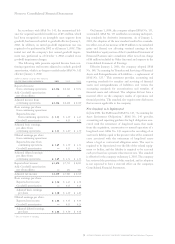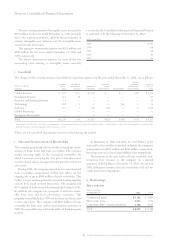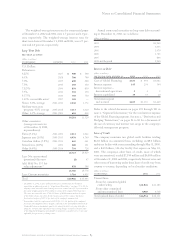IBM 2002 Annual Report Download - page 75
Download and view the complete annual report
Please find page 75 of the 2002 IBM annual report below. You can navigate through the pages in the report by either clicking on the pages listed below, or by using the keyword search tool below to find specific information within the annual report.Notes to Consolidated Financial Statements
73international business machines corporation and Subsidiary Companies
Derivatives
All derivatives are recognized in the Consolidated Statement
of Financial Position at fair value and are reported in Prepaid
expenses and other current assets, Investments and sundry
assets, Other accrued expenses and liabilities or Other liabilities
in the Consolidated Statement of Financial Position.
Classification of each derivative as current or non-current is
based upon whether the maturity of each instrument is less
than or greater than 12 months. To qualify for hedge
accounting in accordance with SFAS No. 133, “Accounting
for Derivative Instruments and Hedging Activities,” as
amended by SFAS No. 138, “Accounting for Certain Derivative
Instruments and Certain Hedging Activities,” (SFAS No.
133), the company requires that the instruments are effective
in reducing the risk exposure that they are designated to
hedge. For instruments that are associated with the hedge of
cash flows, hedge effectiveness criteria also require that it be
probable that the underlying transaction will occur. Instru-
ments that meet established accounting criteria are formally
designated as hedges at the inception of the contract. These
criteria demonstrate that the derivative is expected to be
highly effective at offsetting changes in fair value or cash
flows of the underlying exposure both at inception of the
hedging relationship and on an ongoing basis. The assessment
for effectiveness is formally documented at hedge inception
and reviewed at least quarterly throughout the designated
hedge period.
The company applies hedge accounting in accordance
with SFAS No. 133, whereby the company designates each
derivative as a hedge of; (1) the fair value of a recognized asset
or liability or of an unrecognized firm commitment (“fair
value” hedge); (2) the variability of anticipated cash flows of a
forecasted transaction or the cash flows to be received or paid
related to a recognized asset or liability (“cash flow” hedge);
or (3) a hedge of a long-term investment (“net investment”
hedge) in a foreign operation. From time to time, however,
the company may enter into derivatives that economically
hedge certain of its risks, even though hedge accounting does
not apply under SFAS No. 133 or is not applied by the com-
pany. In these cases, there generally exists a natural hedging
relationship in which changes in fair value of the derivative,
which are recognized currently in net income, act as an eco-
nomic offset to changes in the fair value of the underlying
hedged item(s).
Changes in the value of a derivative that is designated as a
fair value hedge, along with offsetting changes in the fair
value of the underlying hedged exposure, are recorded in
earnings each period. For hedges of interest rate risk, the fair
value adjustments are recorded as adjustments to Interest
expense and Cost of Global Financing in the Consolidated
Statement of Earnings. For hedges of currency risk associated
with recorded assets or liabilities, derivative fair value adjust-
ments generally are recognized in Other (income) and expense
in the Consolidated Statement of Earnings. Changes in the
value of a derivative that is designated as a cash flow hedge are
recorded in the Accumulated gains and (losses) not affecting
retained earnings, a component of Stockholders’ equity. When
net income is affected by the variability of the underlying
cash flow, the applicable offsetting amount of the gain or loss
from the derivative that is deferred in Stockholders’ equity is
released to net income and reported in Interest expense,
Cost, SG&A expense or Other (income) and expense in the
Consolidated Statement of Earnings based on the nature of
the underlying cash flow hedged. Effectiveness for net invest-
ment hedging derivatives is measured on a spot to spot basis.
The effective portion of changes in the fair value of deriva-
tives and other non-derivative risk management instruments
designated as net investment hedges are recorded as foreign
currency translation adjustments in the Accumulated gains
and (losses) not affecting retained earnings section of
Stockholders’ equity. Changes in the fair value of the portion
of a net investment hedging derivative excluded from the
effectiveness assessment are recorded in Interest expense.
When the underlying hedged item ceases to exist, all
changes in the fair value of the derivative are included in
net income each period until the instrument matures.
When the derivative transaction ceases to exist, a hedged
asset or liability is no longer adjusted for changes in its fair
value except as required under other relevant accounting
standards. Derivatives that are not designated as hedges, as
well as changes in the value of derivatives that do not offset
the underlying hedged item throughout the designated hedge
period (collectively, “ineffectiveness”), are recorded in net
income each period and generally are reported in Other
(income) and expense. See note l, “Derivatives and Hedging
Transactions,” on pages 84 to 86 for a description of the
major risk management programs and classes of financial
instruments used by the company.
Financial Instruments
In determining fair value of its financial instruments, the
company uses a variety of methods and assumptions that are
based on market conditions and risks existing at each balance
sheet date. For the majority of financial instruments includ-
ing most derivatives, long-term investments and long-term
debt, standard market conventions and techniques such as
discounted cash flow analysis, option pricing models, replace-
ment cost and termination cost are used to determine fair
value. Dealer quotes are used for the remaining financial
instruments. All methods of assessing fair value result in a
general approximation of value, and such value may never
actually be realized.


